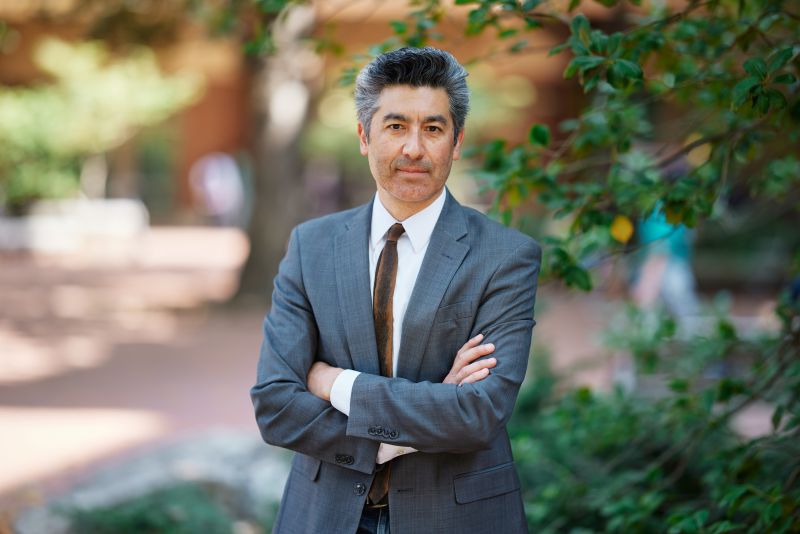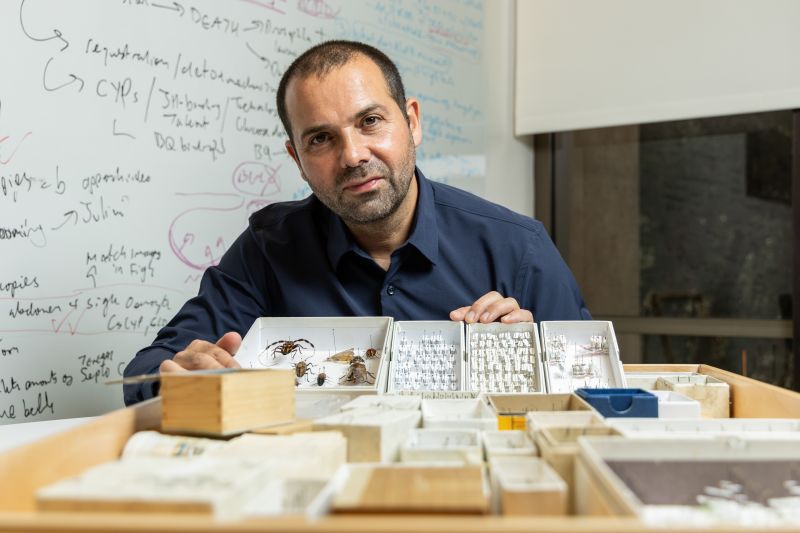Four NSF-supported researchers awarded MacArthur Genius Grants
Albert Einstein once said, "Imagination is more important than knowledge." This idea that the imagination charts a path forward into the unknown is the exploratory nature of science, where discoveries begin.
The John D. and Catherine T. MacArthur Foundation recognizes the importance of imagination with its annual McArthur Fellows awards. Colloquially referred to as the MacArthur Genius Grant, the awards celebrate the extraordinary talent, creativity and potential of its recipients — scientists, writers, artists, teachers, entrepreneurs and more — by bestowing them no-strings-attached fellowships of $800,000.
Among the 22 fellows selected for 2024 were Vanderbilt astrophysicist Keivan Guadalupe Stassun, Woods Hole Oceanographic Institution ocean scientist Ben Van Mooy, Cal Tech evolutionary biologist Joseph Parker, and Yale evolutionary biologist Martha Munoz. The U.S. National Science Foundation has supported the careers of these individuals, who are making a positive difference in our world through their ingenious contributions to science, technology, engineering and mathematics.
"From revealing the ocean’s role in regulating climate to empowering neurodiverse individuals, from decoding the symbiotic secrets of rove beetles to determining what spurs and slows evolution, these MacArthur awardees exemplify the power of curiosity and innovation,” said NSF Director Panchanathan. “NSF recognized their enormous potential early on, investing in their ideas and careers to amplify their contributions to STEM and STEM education. Their groundbreaking work underscores the importance of supporting visionary thinkers who push the boundaries of discovery. Congratulations to these four deserving individuals — trailblazers whose work is enriching knowledge and improving the human condition," said NSF Director Sethuraman Panchanathan.
Keivan Stassun, astrophysicist and science educator
From the beginning, Stassun has dedicated his career to expanding opportunities in STEM for underrepresented groups by spearheading two major initiatives that challenge the limitations of traditional educational and career pathways to improve demographic representation in STEM.
NSF's support for Stassun began in the 1990s with an NSF Graduate Research Fellowship. As a student at the University of Wisconsin–Madison, Stassun said his ideas about the importance of combining scholarly practices in research, teaching and outreach began to crystallize. In 2003, he was awarded a Faculty Early Career Development Program (NSF CAREER) grant — the nation's highest honor for junior faculty who exemplify the role of teacher-scholars through research and education. Over the next two decades, Stassun's work received the support of over 30 NSF awards, helping realize his bold vision for nurturing the unique strengths of all individuals.
In the early 2000s, Stassun co-founded the Fisk-Vanderbilt Master's-to-PhD Bridge Program (FVBP). The program increases the diversity of students receiving advanced degrees in STEM fields by serving as a stepping stone for promising students at Fisk University to gain the experience and skills needed to go directly into a doctorate program. Since it began 18 years ago, 172 students have enrolled in the FVBP, 137 master's degrees have been awarded, 120 students have bridged to doctoral programs and 52 students have earned their doctorate. Today, Fisk University is the number one producer of African American earned master's degrees.
In 2018, he founded the Frist Center for Autism and Innovation, which brings together experts in education, disability, business and engineering to help neurodiverse individuals find and maintain meaningful employment. It also works with leading business scholars to create policies and practices that promote the inclusion of neurodiverse employees; and invents new technologies that remove common barriers to employment for neurodiverse individuals.
"I can draw a line through every stage of my career, where the through-line has been NSF's commitment to societal impact and broadening participation and STEM talent development," said Keivan Stassun. "NSF support has been the juice that fueled my career every step of the way, and in a very real and direct way, the impacts that are being recognized with this honor today would not have been possible otherwise."
As a leader and advocate for minorities in STEM, Stassun's tireless efforts continue to unleash human potential and bring a wider range of perspectives and insights into the STEM workforce. Today, he serves as a National Science Board member, helping guide and direct the strategies that advance NSF's mission.
Benjamin Van Mooy, oceanographer
The crux of Van Mooy's research is "how the ocean works." His lab investigates the impacts that microbial organisms, like plankton, have on marine environments. In particular, his work highlights how changes to marine ecosystems affect food webs, the carbon cycle, climate regulation and other biogeochemical processes.
"When I first got the call from the MacArthur Foundation, I was absolutely convinced they dialed the wrong number," said Van Mooy, senior scientist and interim vice president for science and engineering at Woods Hole Oceanographic Institution. "Now, that disbelief has been replaced with an extreme gratitude for all the folks that have touched my life, particularly the WHOI technical staff members, postdocs, and graduate students that have made my lab group a place to explore creative ideas about how the ocean works."
Over the years, Van Mooy's interdisciplinary research has received the support of 17 NSF grants, funded through the NSF Geosciences and Biological Sciences directorates. Currently, he is one of the co-principal investigators on the NSF Palmer Long-Term Ecological Research program, which is situated on the western side of the Antarctic Peninsula and examines the marine food web's response to the region's rapid warming of the atmosphere and ocean.
The ingenuity of Van Mooy's research has advanced the field of oceanography leading to new methods to characterize the molecular composition of marine snow — the microscopic organic matter falling from the upper layers of the ocean to the deep sea. This molecular characterization is key to untangling the complex systems that stabilize the oceans. According to the MacArthur Fellow team, "Van Mooy is filling critical gaps in our understanding of intricate biogeochemical networks that sustain life on Earth and of how climate change could impact the health and productivity of our oceans."
Joseph Parker, evolutionary biologist
Parker, an evolutionary biologist at California Institute of Technology, was also surprised by his MacArthur award. His work explores the evolution of symbiosis and species interactions by studying populations of rove beetles that coexist with ants. Of the 67,000 identified species of rove beetles, most live independently, yet several lineages have evolved specific traits to survive and thrive within ant colonies.
In 2021, Parker received an NSF CAREER award. This grant, which has a five-year duration and totals over a million dollars, funds Parker's ongoing investigations into the larger questions of how different species recognize and interact with each other — crucial to informing the understanding of how brains process sensory information about other organisms and generate social behavior. The research also has the potential to impact agriculture by leading to the discovery of compounds that limit the ability of pest species to thrive.
"The tiniest, most easily overlooked of the organisms have profound secrets to tell us about our planet and how interactions between species originate," said Parker.
Using molecular and genomic tools combined with a deep understanding of rove beetle diversity, Parker's cutting-edge research revealed the evolutionary pathways from independent, free-living behavior to the symbiotic lifestyle: He discovered that symbiotic rove beetles possess a gland that produces chemicals, allowing them to integrate into the ants' company. This adaptation occurred in multiple independent beetle species over an extended period, a prime example of convergent evolution and a challenge to the thinking that evolution is largely unpredictable over long periods.
"By uncovering how the rove beetle remodeled itself toward symbiotic life, Parker is illuminating long-standing questions about the evolution of interspecies relationships that underpin the natural world," said the MacArthur Fellow team.
Martha Muñoz, evolutionary biologist
While Parker investigates how evolution progresses over time, Muñoz, an assistant professor of ecology and evolutionary biology at Yale University, examines the factors that speed up and slow down the rate of evolutionary change. Studying reptiles, amphibians and fishes, she has helped to uncover how species behavior — such as whether a species eats only one type of food or consumes a broad range of things —and biomechanics impact evolution.
"The part that organisms themselves play in the evolutionary process has been a little bit overlooked," Munoz said. "Behavior can function as this important pacemaker for evolution, capable of accelerating or decelerating the rate at which it occurs."
In one NSF-supported project, she and her colleagues are examining the role of specialization in diet, temperature, and habitat in determining what species of anole lizards dominate the islands of Jamaica, Puerto Rico and Hispaniola. Previous work of hers in anoles has shown that lizards living at the tops of mountains in the Caribbean don't change their body temperature as compared to those that live at sea level. Instead, they spend more time in the sunny areas and on boulders than their low-elevation counterparts who spend more time in the shade. In short, the lizards don't change their physiology but alter how they use their broader environs to recreate their preferred habitat.
The second award supports research into how ecological diversity impacts species diversity among lungless salamanders in the Appalachian Mountains. The work tests if biodiversity is driven by the number of environments a lineage must adapt to, which aids in understanding the origin of biodiversity and how to predict how species may be vulnerable to future environmental change.
"Muñoz is reshaping our understanding of evolutionary determinants and providing critical insights into how changing environments and the day-to-day behavior of organisms will impact long-term patterns of evolution," said the McArthur Foundation.
Learn more about the MacArthur Fellowship and the four NSF-funded fellows: https://www.macfound.org/programs/awards/fellows/






